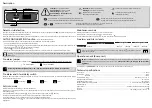
5762H512 Ed.01
AKO-57625-1
Warnings
-Detectors should be installed in a place protected from vibrations, water and corrosive gases, where the ambient temperature does not exceed the value indicated in the technical data.
-Detectors are not suitable for areas classified as potentially explosive.
-Detectors supervise a point and not an area. If the gas leak does not reach the sensor, or the level of concentration in that point does not reach the foreseen values according to the
type of gas no alarm will be activated. If perimeter supervision is required, several sensors should be installed around that area.
Working conditions:
-Avoid handling refrigerant gases near the sensor. If this is unavoidable, use Set Hold or Maintenance mode.
-Keep the detector work environment free of chemical agents (solvents, acetone vapours, paints, alcohol, cleaning products, silicone and derivatives, ethylene, etc.).
-The sensor should be installed away from:
-Smoke outlets located in confined spaces or from engines, generators or motorised machinery (fork-lift trucks, etc.).
-Particularly damp areas or with strong ventilation.
-The detector should usually be installed in an area where gas may concentrate, near to places where gas leaks could start.
-The detector’s location will depend on the refrigerant and will be in areas where gas leaks could concentrate. Taking into account individuals’ safety and their use of space, the lowest position of this space will
be considered for refrigerants heavier than air (HCFC, HFC and CO
2
) and the highest possible position will be considered for refrigerants lighter than air (NH
3
).
Wiring
Always disconnect the power supply to do the wiring.
The wiring between the detector/transmitter and the station should
NEVER
be installed in a conduit together with power, control or supply cables.
Cables for wiring the relay contact should have an adequate section depending on the unit to be connected.
Certain international standards maintain that the power supply of the alarm should originate from a different circuit to that used by the refrigeration and ventilation system.
Please ensure that you
comply with current local regulations.
AKO ELECTROMECÁNICA , S.A.L.
Avda. Roquetes, 30-38
08812 • Sant Pere de Ribes.
Barcelona • Spain.
Tel.: +34 902 333 145
Fax: +34 938 934 054
We reserve the right to supply materials that might vary slightly to those described in our
Technical Sheets. Updated information is available on our website.
355762512 Rev
.00 2021
GB
A
Gnd
DI
1
DI
2
DIG. IN
Remote
Mute
Remote
Set Hold
B
A
“AUTO-CONFIGURATION” push-button
Pre-alarm jumper
Delay switch
B
C
C
NC
NC
NO
Gas
Pre-Alarm
Gas
Alarm
Tr
-
Tr
+
Gnd
RS485 Pre-Alarm Alarm
NO
15V
S
12 - 30 Vdc
Gnd
B
C
C
NC
NC
NO
NO
Gas
Pre-Alarm
Gas
Alarm
Tr
-
Tr
+
Gnd
RS485 Pre-Alarm Alarm
Alarm station
15V
15V
S
In
Gnd
Gnd
Input x
GAS
Connection to alarm station
Independent operation
Gas detector
Quick guide




















